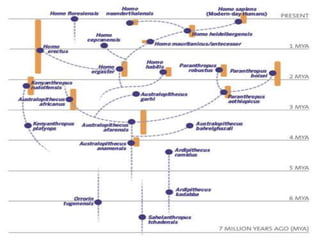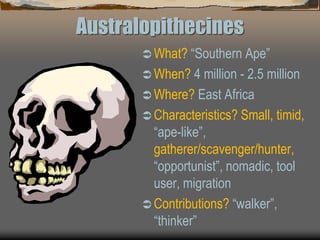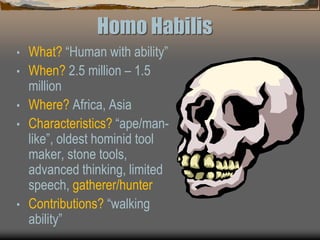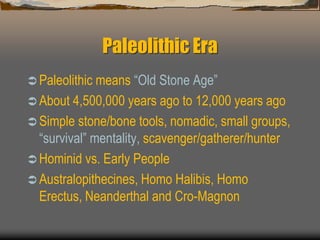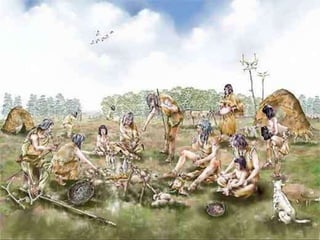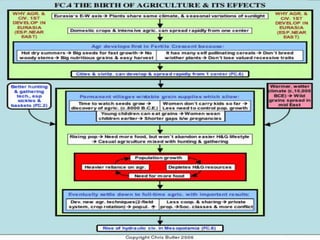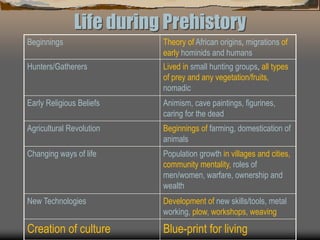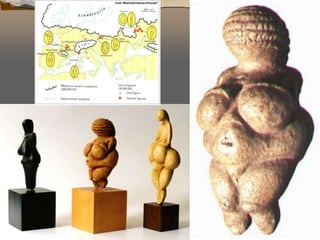Prehistory.ppt
- 3. Archaeologists “DIG” up the past Discover artifacts (man- made objects) and human remains Use curiosity and bias to try and determine what exactly was found
- 4. Anthropologist “STUDY” the past Describe artifacts and remains archaeologists find at dig sites Use inferences/hypotheses, bias and whatever technology available to try and figure out the past
- 5. Historian “TELLS” about the past Uses the information the Archaeologist and Anthropologist gathered to tell about the past Uses whatever technology and resources that are available to share the story of the past
- 6. You “LEARN” about the past Using everything that the previous professionals have done for you; and being curious, look at the material and give an effort to make sense of the past Use resources, ask questions and simply be curious about the past You’re the “puzzle maker”, put it together!
- 9. Where do we begin? How long ago was it? Was it creation or evolution? What hominids or people lived during that time?
- 10. Those are all good questions, but let’s get to the real stuff uncovered and discussed by archaeologists, anthropologists and historians… shall we… have fun and be curious…
- 11. What is prehistory? Prehistory is the time period before written records were kept by people.
- 12. Debate Topic: Creation vs. Evolution What do you think? Creation Belief that a higher power created the world Time is relative with everything beginning at the same time Beliefs, animals, people and civilization have common origins Evolution Belief that the world was created over billions of years Time is constant with everything happening as a result of earlier things Beliefs, animals, people and civilizations have developed over time, but have similar origins
- 19. Australopithecines What? “Southern Ape” When? 4 million - 2.5 million Where? East Africa Characteristics? Small, timid, “ape-like”, gatherer/scavenger/hunter, “opportunist”, nomadic, tool user, migration Contributions? “walker”, “thinker”
- 21. Homo Habilis • What? “Human with ability” • When? 2.5 million – 1.5 million • Where? Africa, Asia • Characteristics? “ape/man- like”, oldest hominid tool maker, stone tools, advanced thinking, limited speech, gatherer/hunter • Contributions? “walking ability”
- 23. Homo Erectus What? “Walking Ability” When? 1.6 million – 250,000 b.c. Where? Africa, Europe and Asia Characteristics? Adapted to environment, gatherer/scavenger/hunter, improved tool maker, fire, clothing Contributions? “Sophisticated thinking”
- 25. Neanderthals What? Hominid, “Missing Link” When? 200,000 b.c. – 50,000 b.c. Where? Europe, Asia Characteristics? Stocky, muscular, adapted to environment, hunter/gatherer, fire, superstitions, sophisticated ideas – language, beliefs, tools, ideas, sensitivity, creativity Contributions? “Cultural Beliefs”
- 27. Cro-Magnon What? “Modern Man” When? 50,000 b.c. – present day Where? All continents, except Antarctica Characteristics? “US”, earliest modern-looking people, created the basis for modern civilization Contributions? Our world and civilization
- 29. Eras of Prehistory Concepts to know – Paleolithic – Old Stone Age 4.5 million y.a. - 12,000 y.a. Mesolithic – Middle Stone Age 12,000 y.a. – 10,000 y.a. Neolithic – New Stone Age 10,000 y.a. – 8,000 y.a.
- 30. Paleolithic Era Paleolithic means “Old Stone Age” About 4,500,000 years ago to 12,000 years ago Simple stone/bone tools, nomadic, small groups, “survival” mentality, scavenger/gatherer/hunter Hominid vs. Early People Australopithecines, Homo Halibis, Homo Erectus, Neanderthal and Cro-Magnon
- 37. Mesolithic Era Means “Middle Stone Age” About 12,000 years ago to 10,000 years ago Improved methods of tool making (polished stone), semi-nomadic, animism, artwork and beliefs, life after death, hunter/gatherer/early farming experimentation Advancements of early human groupings (Neanderthal and Cro-Magnon) Major movement toward creation of civilization
- 41. Neolithic Era Means “New Stone Age” About 10,000 years ago to 8000 years ago Creation of tools out of metal instead of stone, permanent settlements, farmer/hunter/gatherer, division of labor, domestication of animals for labor/food, plow, weaving Development of permanent societies led to the development of civilization
- 45. Life during Prehistory Beginnings Theory of African origins, migrations of early hominids and humans Hunters/Gatherers Lived in small hunting groups, all types of prey and any vegetation/fruits, nomadic Early Religious Beliefs Animism, cave paintings, figurines, caring for the dead Agricultural Revolution Beginnings of farming, domestication of animals Changing ways of life Population growth in villages and cities, community mentality, roles of men/women, warfare, ownership and wealth New Technologies Development of new skills/tools, metal working, plow, workshops, weaving Creation of culture Blue-print for living
- 51. *** IMPORTANT CONCEPT TO UNDERSTAND*** ASSIMILATION: Blending of cultures
- 52. Creation of culture led to the creation of civilization Characteristics of Civilization – Cities Organized Governments Religion Division of Labor Social Classes Arts and Architecture Public Works Projects Writing
- 54. River Valley Civilizations Mesopotamia Egypt Indus China
Editor's Notes
- #56: Where are the 4 Cradles of Civilization (River Valley Civilizations)? What similarities does each RVC have in common with the others? (knowledge)
















